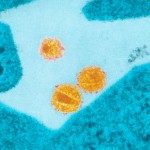Lien vers Pubmed [PMID] – 29739880
Sci Signal 2018 05;11(529)
Biophysical methods and x-ray crystallography have revealed that class A G protein-coupled receptors (GPCRs) can form homodimers. We combined computational approaches with receptor cross-linking, energy transfer, and a newly developed functional export assay to characterize the residues involved in the dimerization interfaces of the chemokine receptor CCR5, the major co-receptor for HIV-1 entry into cells. We provide evidence of three distinct CCR5 dimeric organizations, involving residues of transmembrane helix 5. Two dimeric states corresponded to unliganded receptors, whereas the binding of the inverse agonist maraviroc stabilized a third state. We found that CCR5 dimerization was required for targeting the receptor to the plasma membrane. These data suggest that dimerization contributes to the conformational diversity of inactive class A GPCRs and may provide new opportunities to investigate the cellular entry of HIV-1 and mechanisms for its inhibition.




